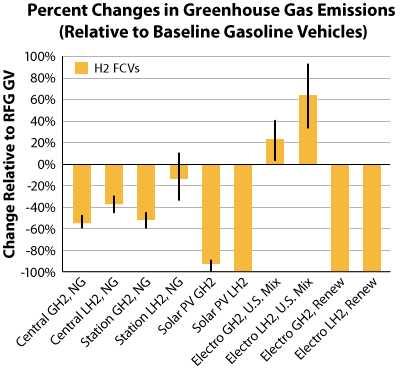Fuel Cell Electric Vehicle Emissions
Fuel cell electric vehicles emit only water vapor and warm air, producing no harmful tailpipe emissions. Similar to electricity, hydrogen is an energy carrier that can be produced from various feedstocks. These feedstocks and production methods should be considered when evaluating hydrogen emissions.
The U.S. Department of Energy and Argonne National Laboratory (ANL) presentation, Learn to use the GREET Model for Emissions Life Cycle Analysis, provides viewers information about analyzing greenhouse gas (GHG) emissions for hydrogen production and distribution pathways. ANL shows that gaseous hydrogen produces fewer GHGs than liquid hydrogen in most cases. ANL has also investigated hydrogen's effects on petroleum use and found that using hydrogen as a fuel reduced petroleum use by nearly 100% regardless of fuel production pathway.

Relative to gasoline vehicles (GVs) fueled by reformulated gasoline (RFG), hydrogen production for all fuel pathways creates fewer GHG emissions except when the fuel is produced by electrolysis from typical grid electricity. As the renewable content in the grid mix increases, the GHG emissions for electrolysis from that grid will be reduced as the GHG emissions come from the non-renewable portion of the grid mix.